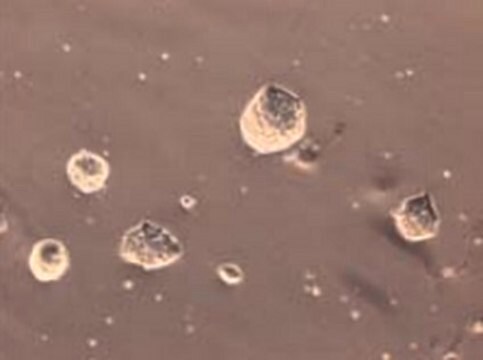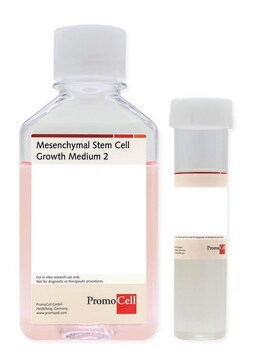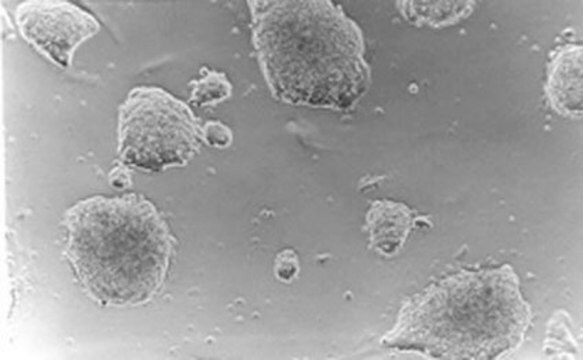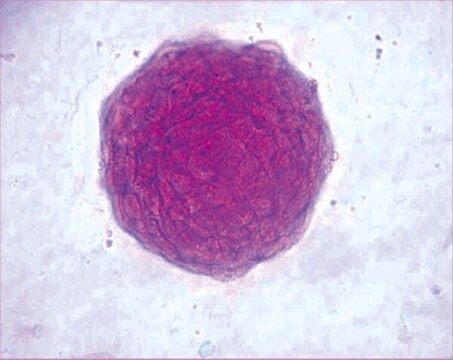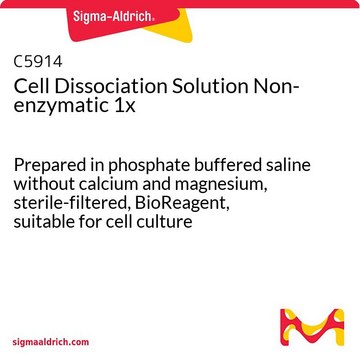SF006
ESGRO Complete Accutase
The ESGRO Complete Accutase is a cell detachment solution of proteolytic & collagenolytic enzymes, qualified for use for the detachment of mouse embryonic stem cells cultured in serum-free conditions with ESGRO Complete Clonal Grade Medium.
Synonim(y):
Accutase testowany na komórkach macierzystych
Zaloguj sięWyświetlanie cen organizacyjnych i kontraktowych
About This Item
Kod UNSPSC:
12352207
eCl@ss:
32160801
NACRES:
NA.75
Polecane produkty
Poziom jakości
Formularz
liquid
producent / nazwa handlowa
Chemicon®
metody
cell culture | stem cell: suitable
moc wejściowa
sample type: mouse embryonic stem cell(s)
sample type induced pluripotent stem cell(s)
Warunki transportu
dry ice
Opis ogólny
ESGRO Complete™ Accutase is a cell detachment solution of proteolytic and collagenolytic enzymes that has been qualified for use for the detachment of mouse embryonic stem cells cultured in serum-free conditions with ESGRO Complete Clonal Grade Medium (Cat. No. SF001-500). Accutase does not contain mammalian or bacterial derived products.
Zastosowanie
Cell Detachment:
1. Thaw Accutase® to room temperature.
2. Wash plate, flask or beads with sterile PBS.
3. Add Accutase to culture dish or flask using aseptic procedures at 10 mL per 75 cm2 surface area.
4. Return culture to 37°C incubator and allow cells to detach (5-10 minutes).
5. Count cells and passage as usual. No additional washes or enzyme inhibitors are required.
1. Thaw Accutase® to room temperature.
2. Wash plate, flask or beads with sterile PBS.
3. Add Accutase to culture dish or flask using aseptic procedures at 10 mL per 75 cm2 surface area.
4. Return culture to 37°C incubator and allow cells to detach (5-10 minutes).
5. Count cells and passage as usual. No additional washes or enzyme inhibitors are required.
Postać fizyczna
Frozen sterile liquid, ready to use formulation. Each lot is tested for Sterility (by USP membrane filtration method), enzymatic activity (tested with synthetic chromagenic tetrapeptides) and cell detachment from tissue culture plastic.
1X Accutase® enzymes in Dulbecco′s PBS containing 0.5 mM EDTA•4Na and 3 mg/L Phenol Red.
1X Accutase® enzymes in Dulbecco′s PBS containing 0.5 mM EDTA•4Na and 3 mg/L Phenol Red.
Przechowywanie i stabilność
Stable when stored at -20°C. Refer to lot expiration date on label. Recommended storage upon receipt is -20°C. After thawing, Accutase® may be stored for up to 2 months at 4°C. DO NOT STORE AT ROOM TEMPERATURE.
Informacje prawne
Accutase is a registered trademark of Innovative Cell Technologies, Inc.
CHEMICON is a registered trademark of Merck KGaA, Darmstadt, Germany
cOmplete is a trademark of Roche
Ta strona może zawierać tekst przetłumaczony maszynowo.
Kod klasy składowania
12 - Non Combustible Liquids
Klasa zagrożenia wodnego (WGK)
WGK 1
Temperatura zapłonu (°F)
Not applicable
Temperatura zapłonu (°C)
Not applicable
Certyfikaty analizy (CoA)
Poszukaj Certyfikaty analizy (CoA), wpisując numer partii/serii produktów. Numery serii i partii można znaleźć na etykiecie produktu po słowach „seria” lub „partia”.
Masz już ten produkt?
Dokumenty związane z niedawno zakupionymi produktami zostały zamieszczone w Bibliotece dokumentów.
Klienci oglądali również te produkty
Nasz zespół naukowców ma doświadczenie we wszystkich obszarach badań, w tym w naukach przyrodniczych, materiałoznawstwie, syntezie chemicznej, chromatografii, analityce i wielu innych dziedzinach.
Skontaktuj się z zespołem ds. pomocy technicznej




